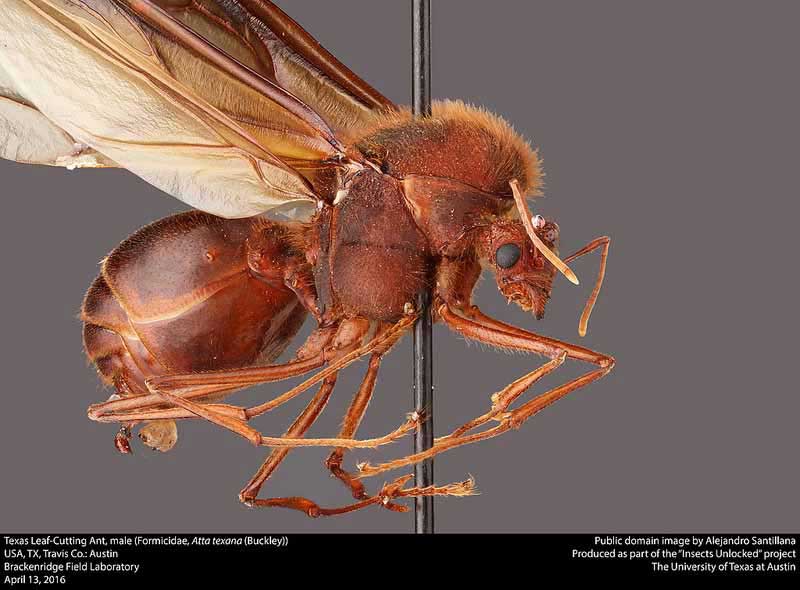
Superregnum: Eukaryota
Cladus: Unikonta
Cladus: Opisthokonta
Cladus: Holozoa
Regnum: Animalia
Subregnum: Eumetazoa
Cladus: Bilateria
Cladus: Nephrozoa
Cladus: Protostomia
Cladus: Ecdysozoa
Cladus: Panarthropoda
Phylum: Arthropoda
Subphylum: Hexapoda
Classis: Insecta
Cladus: Dicondylia
Subclassis: Pterygota
Cladus: Metapterygota
Infraclassis: Neoptera
Cladus: Eumetabola
Cladus: Endopterygota
Superordo: Hymenopterida
Ordo: Hymenoptera
Subordo: Apocrita
Superfamilia: Formicoidea
Familia: Formicidae
Subfamilia: Myrmicinae
Tribus: Attini
Genus: Atta
Species: Atta texana
Name
Atta texana (Buckley, 1860)
Synonyms
Myrmica texana Buckley
Oecodoma texana (Buckley)
References
Buckley, S.B. 1860: The cutting ant of Texas. Proceedings of the Academy of Natural Sciences of Philadelphia, 12: 233–236.
Atta texana is a fungus-farming ant species of the genus Atta, found in Texas, Louisiana, and northeastern states of Mexico.[1] Common names include town ant, parasol ant, fungus ant, Texas leafcutter ant, cut ant, and night ant. It harvests leaves from over 200 plant species, and is considered a major pest of agricultural and ornamental plants,[2] as it can defoliate a citrus tree in less than 24 hours. Every colony has several queens and up to 2 million workers. Nests are built in well-drained, sandy or loamy soil, and may reach a depth of 6 m (20 ft), have 1000 entrance holes, and occupy 420 m2 (4,500 sq ft).[1]
Description
A. texana workers measure 4 to 14 mm (0.16 to 0.55 in) in length, and are highly polymorphic. The back of the thorax has three pairs of spines. The ant has a narrow waist and is rusty brown in color.[1] It should also be mentioned: Its closely-related cousin, Atta mexicana has colonies up to 8 Million, and the queen for A. mexicana is larger than the texana queen; however, it should also be mentioned that A. mexicana is only able to have a single queen, while A. texana may have multiple queens (Often 2)
Behavior
The nuptial flights of A. texana synchronize in regions; the virgin queens and males fly at night.[3]
References
Robinson, William H. (2005). Handbook of Urban Insects and Arachnids. Cambridge University Press. pp. 238–239. ISBN 978-0-521-81253-5.
"Texas Leaf Cutting Ant". Insects in the City. Texas AgriLife Extension. 2006-08-30. Archived from the original on October 15, 2008. Retrieved 2010-01-04.
Hölldobler, Bert; Holldobler, Foundation Professor of Biology Bert; Wilson, Honorary Curator in Entomology and University Research Professor Emeritus Edward O.; Wilson, Edward O. (2009). The Superorganism: The Beauty, Elegance, and Strangeness of Insect Societies. W. W. Norton & Company. ISBN 9780393067040.
Evans, Arthur V (2007). "Ants, Bees, and Wasps: Order Hymenoptera". National Wildlife Federation Field Guide to Insects and Spiders & Related Species of North America. Sterling Publishing Co., Inc. p. 380. ISBN 978-1-4027-4153-1.
Retrieved from "http://en.wikipedia.org/"
All text is available under the terms of the GNU Free Documentation License

